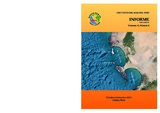Por favor, use este identificador para citar o enlazar este ítem:
https://hdl.handle.net/20.500.12958/3000Registro completo de metadatos
| Campo DC | Valor | Lengua/Idioma |
|---|---|---|
| dc.contributor.author | Quiñones Dávila, Javier | |
| dc.contributor.author | Paredes, Evelyn | |
| dc.contributor.author | Quispe Cayhualla, Sixto | |
| dc.contributor.author | Delgado, Luis | |
| dc.date.accessioned | 2016-03-30T19:23:58Z | |
| dc.date.available | 2016-03-30T19:23:58Z | |
| dc.date.issued | 2015 | |
| dc.identifier.citation | Inf Inst Mar Perú 42(4), 2015. p. 516-525 | es_ES |
| dc.identifier.uri | https://hdl.handle.net/20.500.12958/3000 | |
| dc.description | Informe IMARPE;Vol. 42, N° 4, 2015 , p. 516-525 | es_ES |
| dc.description.abstract | Durante el 2010, se capturó 55 ejemplares de tortuga verde Chelonia mydas en La Aguada (13°51’S y 76°15’W) al sureste de la bahía de Paracas; el número promedio de tortugas capturadas por kilómetro de red tendida fue 3,08±2,5; el tamaño promedio de la LCC fue 60,3±10,5cm; el 78% de los ejemplares presentaron el patrón 5c, 4d, 4i y 11d, 11i, para los escudos centrales, costales y marginales, respectivamente. La TSM donde se capturaron varió entre 15,2 y 20,9 °C, la mayor ocurrencia de tortugas se registró de 18,5 a 20 °C. Los epibiontes más representativos fueron Platylepas hexastylos (56,8%), Conchoderma virgatum (26,9%) y Chelonibia testudinaria (13,3%); la ocurrencia de los ítems alimenticios: Clorophyta (78%), Rhodophyta (30%), Cnidaria (43%), Crustacea (43%), Polichaeta (17%), Mollusca (17%), arena (26%) y plástico (17%); el 72% de las tortugas presentaron cobertura algal, de las cuales el 65% fue el alga verde Enteromorpha sp. | es_ES |
| dc.description.abstract | ABSTRACT: During 2010, we captured 55 samples of green turtle Chelonia mydas in La Aguada (13°51’S and 76°15’W) to the southeast of Paracas Bay; the average number of turtle caught per kilometre of network lying was 3,08 ±2,5; the average size of the LCC was 60,3 ±10.5 cm; 78% of the specimens showed the pattern 5c, 4d, 4i and 11d, 11i for central shields, costal and marginal, respectively. The TSM where captured varied between 15.2 and 20.9 °C, the highest occurrence of turtles was recorded from 18.5 to 20 °C. The most representative epibionts were Platylepas hexastylos (56.8%), Conchoderma virgatum (26.9%) and Chelonibia testudinaria (13.3%); the occurrence of food items: Clorophyta (78%), Rhodophyta (30%), Cnidaria (43%), Crustacea (43%), Polichaeta (17%), Mollusca (17%), sand (26%) and plastic (17%); 72% of the turtles presented algal coverage, of which 65% was green algae Enteromorpha sp. | |
| dc.description.sponsorship | Instituto del Mar del Perú | es_ES |
| dc.language.iso | spa | es_ES |
| dc.publisher | Callao | es_ES |
| dc.relation.ispartofseries | Informe IMARPE;Vol. 42, N° 4, 2015 | |
| dc.rights | info:eu-repo/semantics/openAccess | es_ES |
| dc.rights.uri | https://creativecommons.org/licenses/by/4.0/ | - |
| dc.source | Instituto del Mar del Perú - IMARPE | es_ES |
| dc.source.uri | Repositorio Digital IMARPE | es_ES |
| dc.subject | Tortuga Verde | es_ES |
| dc.subject | Chelonia Mydas | es_ES |
| dc.subject | Bahía De Paracas - Ica | es_ES |
| dc.title | Tortugas marinas durante el 2010 en Pisco, Perú | es_ES |
| dc.title.alternative | Sea turtles during 2010 in Pisco, Perú | es_ES |
| dc.type | info:eu-repo/semantics/article | es_ES |
| Aparece en las colecciones: | Informe vol. 42(4) 2015 | |
Ficheros en este ítem:
| Fichero | Descripción | Tamaño | Formato | |
|---|---|---|---|---|
| Informe 42(4)-10.pdf | 2,32 MB | Adobe PDF |  Visualizar/Abrir |
Este ítem está sujeto a una licencia Creative Commons Licencia Creative Commons

